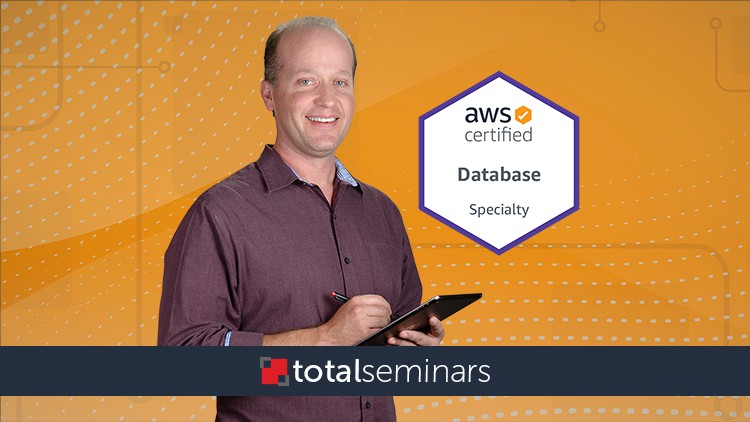TOTAL: AWS Certified Database Specialty Exam Prep (DBS-C01)
- Description
- Curriculum
- FAQ
- Reviews
The TOTAL Seminars Team brings you one of our most popular Instructors, Tom Carpenter is the Chief Technical Officer at CWNP (Certified Wireless Network Professionals). He’s been in the IT industry for 25+ years, written over 20 books on IT subjects, and is also heavily involved in objectives development and exam creation in the certification industry.
Tom walks you through how Database Administrators (DBAs) move their databases to the cloud using AWS. It is helpful for anyone who deals with any aspect of databases in AWS.
AWS has come out with a BRAND NEW certification exam called the AWS Certified Database – Specialty (DBS-C01). The exam was created specifically for those who are interested in the database aspects of AWS.
Do you know how data has radically changed the landscape of everything in the cloud, the Internet, and your lives? If you’ve ever seen the “Customers also bought” tag on Amazon (that lead you to buy that super cool Bluetooth-enabled R2-D2), or used the databases in your company to better understand where the best places are to invest your profits, or simply used the contacts function of your phone to store all the important information about the people in your lives, you know how crucial data is. All these keep information in databases and most databases are housed in the AWS Cloud.
Although this course is designed with Database Administrators (DBAs) in mind, it is helpful for anyone who deals with any aspect of databases in AWS. This exam covers everything from the AWS Relational Database Service (RDS) to NoSQL databases (DynamoDB) to the AWS Database Migration Tool. It focuses on various aspects, such as design, migration, deployment, maintenance, security, monitoring, and disaster recovery.
FEATURES & BENEFITS
· Over 8 hours of content
· 9 downloadable PDFs with notes on every chapter
· 9 white paper PDFs suggested by AWS to study for the exam
· End-of-chapter quizzes to test your knowledge
· Q&A section where you can have your questions answered
· 30-day money-back guarantee
· Lifetime access
· Certificate of completion
WHAT’S COVERED?
· AWS Relational Database Service (RDS) and Aurora
· AWS DynamoDB (document database)
· AWS Database Migration Tool (migrate your existing databases into the cloud)
· AWS Key Management Service (encryption to secure your data)
· Troubleshooting database connection issues
· AWS Neptune (graph database)
· AWS Redshift (data warehousing)
The AWS Certified Database – Specialty exam domains covered are:
· Domain 1: Workload-Specific Database Design 26%
1.1 Select appropriate database services for specific types of data and workloads
1.2 Determine strategies for disaster recovery and high availability
1.3 Design database solutions for performance, compliance, and scalability
1.4 Compare the costs of database solutions
· Domain 2: Deployment and Migration 20%
2.1 Automate database solution deployments
2.2 Determine data preparation and migration strategies
2.3 Execute and validate data migration
· Domain 3: Management and Operations 18%
3.1 Determine maintenance tasks and processes
3.2 Determine backup and restore strategies
3.3 Manage the operational environment of a database solution
· Domain 4: Monitoring and Troubleshooting 18%
4.1 Determine monitoring and alerting strategies
4.2 Troubleshoot and resolve common database issues
4.3 Optimize database performance
· Domain 5: Database Security 18%
5.1 Encrypt data at rest and in transit
5.2 Evaluate auditing solutions
5.3 Determine access control and authentication mechanisms
5.4 Recognize potential security vulnerabilities within database solutions
MORE ABOUT THE AWS CERTIFIED DATABASE – SPECIALTY EXAM
· Exam code: DBS-C01
· Exam voucher cost: $300 USD
· Exam languages: English, Japanese, Korean, and Simplified Chinese
· Exam format: Multiple-choice, multiple-answer
· Number of questions: 55-65 (estimate)
· Length of exam: 180 minutes
· Passing grade: Score is from 100-1000, passing grade of 750
· AWS certifications are valid for 3 years, after which you must recertify (you get a 50% off voucher for your recertification exam from AWS)
How to take the exam:
· Sign up for a free AWS Training and Certification account***
· Once logged in, select “Schedule New Exam”
· Exam can be taken at your local Pearson-VUE testing center and is given via computer
ABOUT YOUR INSTRUCTOR
Tom Carpenter is the Chief Technical Officer at CWNP (Certified Wireless Network Professionals). He’s been in the IT industry for 25+ years, written over 20 books on IT subjects, and is also heavily involved in objectives development and exam creation in the certification industry. Tom uses AWS daily to run several business websites and operate test labs used for content creation and management, among other things. Tom’s teaching style is casual; he wants you to have fun while you learn practical applications of AWS. Join our class now and let us know how you plan to use AWS in your personal or professional life!
-
1IntroductionVideo lesson
-
2AWS Database – Specialty Recommended KnowledgeVideo lesson
When preparing for any certification, it is always best to start with the objectives. A solid understanding of exam objectives is the first step to success.
-
3Databases DefinedVideo lesson
Before working with databases in AWS, it is important to understand databases in general. This episode introduces the concept of a database and several important database terms.
-
4Relational DatabasesVideo lesson
Historically, the most popular kind of database has been the relational database, at least for the past 20 years or so. Before that, flat databases were more popular and NoSQL databases are growing in popularity today. This episode introduces relational databases and their concepts.
-
5Database Management System (DBMS)Video lesson
In the cloud, AWS can provide a fully managed DBMS, but what is a DBMS? This episode explains the concepts to help you understand what AWS is providing to you with the AWS Relational Database System and other managed databases.
-
6Cloud-Based vs. Local DatabasesVideo lesson
Beyond basic description, important performance differences exist between most local, networked and cloud databases systems. With faster Internet connections, the differences are minimized, but must be considered and this episode explains those differences.
-
7Database ApplicationsVideo lesson
Database applications are the clients of database management systems. This episode explores database applications and the various types available.
-
8Database Access LanguagesVideo lesson
Database access languages are used to query, modify, and even create databases. This episode explains the common database access languages available.
-
9Introducing SQLVideo lesson
SQL is the most popular language used to access databases. It is supported by all major relational databases and this episode introduces the components of the SQL language.
-
10Reading Data with SQLVideo lesson
Storing data is not extremely useful if you cannot read that data later. This episode covers the SELECT statement used to read data from your databases.
-
11Writing Data with SQLVideo lesson
Just as you can read data with SQL, you can write data. This is performed with the change capable DML statements and they are covered in this episode.
-
12Working with Database ObjectsVideo lesson
When you need to create objects in the database, you will use DDL SQL statements. These include CREATE and DROP as primary commands and they are covered in this episode.
-
13Introducing Databases QuizQuiz
-
14AWS Database ServicesVideo lesson
To begin understanding specific AWS database services, you must first understand the concept of managed vs. hosted database services. This episode explains these concepts and how AWS addresses them.
-
15Relational Databases (Aurora, Redshift, RDS)Video lesson
AWS supports several relational databases and this episode introduces these databases and their capabilities. This information will help you select the best database for your needs.
-
16Key-Value (NoSQL) Databases (DynamoDB)Video lesson
NoSQL databases are those that do not adhere to traditional relational database structures and instead use a key-value pairing data storage methodology. This episode explains these databases with examples of available solutions in AWS.
-
17In-Memory Databases (ElastiCache)Video lesson
Sometimes, the performance requirement of a database system is such that disk-based access is not sufficient. For this, in-memory databases can be used and this episode introduces and explains the concept.
-
18Document Databases (Document DB)Video lesson
Document databases introduce some confusion to the newly initiated as they sound like a database used to store Word documents, PDF files, and other document types. However, in a document database, the term document carries a different meaning and this episode explains that
-
19Graph Databases (Neptune)Video lesson
Graph databases are specialized databases optimized for storing and navigating relationships (graphs). This episode explores Neptune, the AWS graphing database.
-
20Time Series Databases (Timestream)Video lesson
Tracking values over time is becoming increasingly important with the massive growth in the Internet of Things (IoT) market and other use cases. Time series databases are specifically designed for this kind of tracking and this episode explains Timestream, the AWS time series database.
-
21Ledger Databases (QLDB)Video lesson
Financial tracking and compliance are important issues in modern business. Ledger database systems, such as AWS QLDB, are useful in achieving compliance and this episode explains this AWS database solution.
-
22Instance-Based Database ServersVideo lesson
At times, you may be required to implement a hosted database management system (instance-based database server) to meet application or other compatibility requirements. This episode lays the foundation for this requirement by addressing the creation of a Linux instance.
-
23Access Control and AuthenticationVideo lesson
One of the most important steps in DBMS deployment is proper security implementation. Access control and authentication are managed differently depending on whether the database is hosted or managed and this episode shows how they differ.
-
24Database Services QuizQuiz
-
25Designing DatabasesVideo lesson
All quality databases begin with good design. The design ensures that the database implemented meets the requirements of the project. This episode introduces the database design concept.
-
26Using an ERD ToolVideo lesson
Database design tools are an important part of the DBA’s toolkit. Such tools allow the DBA to model the database and show its relationships. This episode explains and demonstrates such tools.
-
27Designing Database SolutionsVideo lesson
While the database itself is important, the environment in which it is made available is just as important. This episode provides guidance related to the building of an entire database solution.
-
28Designing for PerformanceVideo lesson
Optimizing a database solution for performance may be important for a heavily used database or a large database that runs intensive tasks. This episode provides guidance on designing a well-performing database.
-
29Designing for ScalabilityVideo lesson
It is quite common that a DBA is required to “grow” a database solution. This scalability allows the system to meet increasing demands and this episode explains how scalability is accomplished in AWS.
-
30Designing for ComplianceVideo lesson
In some organizations, compliance is a legal requirement. In others, it is a policy requirement. In either case, AWS helps you to achieve compliance with their database solutions and this episode shows you where eto find information on the compliance requirements you may face.
-
31Planning for RecoveryVideo lesson
Recovery begins with backup. This episode explains the backup processes and options related to Amazon RDS and instance-based database solutions in AWS.
-
32Planning for High AvailabilityVideo lesson
Many database solutions require high availability, which indicates that the solution is available more often than a low- or standard-availability solution. This episode explains AWS high availability options.
-
33Planning for EncryptionVideo lesson
Encryption is important for both security and compliance within database systems. This episode explains both at rest encryption and in transit encryption.
-
34Database Design QuizQuiz
-
35Creating RDS DatabasesVideo lesson
With a solid plan for a database, you’re ready to begin creating actual database solutions. This episode addresses important pre-creation tasks and then provides a hands-on experience creating an RDS database
-
36Connecting to an RDS Database (MySQL Workbench)Video lesson
After creating a database in RDS, the first thing you should do is connect to it to ensure that everything is working as expected. This episode walks you through the process.
-
37Creating DynamoDB DatabasesVideo lesson
When you require a NoSQL database, in AWS, DynamoDB is the primary database to use. This episode walks you through the quite simple process of creating a DynamoDB database.
-
38Creating RedShift DatabasesVideo lesson
Redshift is the AWS data warehousing solution. It requires a cluster configuration to implement it. This episode walks you through the basic process
-
39Creating DocumentDB DatabasesVideo lesson
As you learned previously in this course, DocumentDB is a database for storing documents in JSON format. In this episode, you will see how to create a DocumentDB table.
-
40Creating Instance-Based DatabasesVideo lesson
In this episode, you will see the database ready and OS ready AMIs in the AWS Marketplace. These AMIs can be used to quickly launch and instance-based database solution.
-
41Creating Databases from the CLIVideo lesson
The AWS CLI (Command Line Interface) is a set of commands that can be installed on a local computer or AWS instance and used to manage AWS services, including database. This episode provides references you can use to learn the CLI.
-
42Automation of Database CreationVideo lesson
When large numbers of databases must be created or you desire to script the creation of databases, automation can be used. A primary method of automation in CloudFormation and it is explained in this episode.
-
43Orchestration of Database CreationVideo lesson
The primary difference between automation and orchestration is the number of objects created. This episode explores orchestration through multiple templates use in CloudFormation.
-
44Database Deployment QuizQuiz
-
45Migration StrategiesVideo lesson
Any database migration process should begin with a good strategy. Formulating an effective strategy requires knowing what you have now and what you need in the end. This episode explains both.
-
46Preparing Data for MigrationVideo lesson
Before migration can occur, the source data should be prepared. This may include archiving older data, exporting data, and backing up data. This episode explains the importance of these processes.
-
47Preparing the Cloud to Receive DataVideo lesson
The next step, after preparing data for migration, is to prepare the destination – in this case the AWS cloud. This episode explains the basic steps required to prepare for migration in AWS.
-
48Executing Data MigrationVideo lesson
Now that we’ve discussed the planning process, in this episode, we will demonstrate a data migration using a SQL Server database as an example
-
49Validating Data MigrationVideo lesson
After the data migration, you should not assume that the process was successful. Instead, you should validate the migration and this episode discussed the methods that may be used.
-
50Migrating using DMSVideo lesson
The Database Migration Service (DMS) is used to migrate data. This episode explores the process.
-
51Database Migration QuizQuiz
-
52General Maintenance ProcessesVideo lesson
Creating a database is just the start. Managing that database throughout its lifecycle is just as important. This episode explains the basic processes used in database management.
-
53Specific Maintenance TasksVideo lesson
In this episode, you will learn to extract and load data as well as archive data. All three are demonstrated.
-
54Backup and Restore StrategiesVideo lesson
Planning for backups is a key component of database management. You should always understand the backup options available to you so that you can select the best backup methods. This episode is all about developing strategies for backups.
-
55Performing an Unmanaged Database BackupVideo lesson
In this episode, you will see how to backup an unmanaged database, such as one hosted in an EC2 instance within AWS.
-
56Performing a Managed Database BackupVideo lesson
In this episode, you will see how to perform manual backups on a managed database, such as one hosted in AWS RDS.
-
57Performing a RestorationVideo lesson
In this episode, you will learn about the final important component in database backups: restoration. Both managed and unmanaged database restorations are addressed.
-
58Managing Databases QuizQuiz
-
59Managing RDSVideo lesson
In this episode, you will explore the basic management practices related to RDS managed databases. These practices include modifying an RDS instance and working with Option and Parameter groups.
-
60Managing DynamoDBVideo lesson
Managing DynamoDB is about creating and managing clusters and working with the data in the database. This episode explores creating a DynamoDB Accelerator (DAX) cluster.
-
61Managing RedshiftVideo lesson
Amazon Redshift is designed to scale to very large databases, up to the petabyte scale. For this reason, it depends heavily on clustering technologies. This episode explores the ways in which clusters interact with other AWS services.
-
62Managing Other DatabasesVideo lesson
Unmanaged databases are instance-based databases. This simply means that they are not managed automatically. This episode explores the ways in which you manage an unmanaged database.
-
63General Operational Environment ManagementVideo lesson
As with local systems, cloud systems also require general operational environment management. The users, groups, servers, and security must be managed and this episode explores these concepts in the context of the AWS cloud.
-
64Managing Database Services QuizQuiz
-
65Introduction to MonitoringVideo lesson
Monitoring database operations is essential to effective management and security. This episode introduces the monitoring concepts that are addressed throughout this chapter.
-
66AWS Alert ServicesVideo lesson
AWS alert services can be used to notify you when something is improperly configured, or improper actions are taken. To achieve this, you must first log the appropriate events and CloudTrail is the tool for this.
-
67Using CloudWatchVideo lesson
CloudWatch can monitor and report on events logged by CloudTrail and other events as well. This is your actual alerting service within AWS and this episode explains its use.
-
68Using Third-Party Monitoring ToolsVideo lesson
In addition to the AWS and DBMS monitoring tools, some third-party companies develop tools for cloud monitoring. These tools will not be covered on the AWS Database exam, but it would not be a complete course without mentioning them.
-
69Auditing through MonitoringVideo lesson
Auditing is important to security and compliance and monitoring can be helpful. This episode introduces auditing concepts and monitoring’s role in auditing.
-
70Special Security Auditing ToolsVideo lesson
AWS includes specific tools that can be helpful for security auditing. This episode describes several of these tools.
-
71Improving Database PerformanceVideo lesson
One of the end goals of monitoring is the improvement of performance with databases. To wrap up this chapter, we will explore several tips for performance enhancement.
-
72Monitoring Database Solutions QuizQuiz

External Links May Contain Affiliate Links read more





